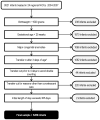Variations in definitions of mortality have little influence on neonatal intensive care unit performance ratings
- PMID: 22854328
- PMCID: PMC3782108
- DOI: 10.1016/j.jpeds.2012.06.002
Variations in definitions of mortality have little influence on neonatal intensive care unit performance ratings
Abstract
Objective: To measure the influence of varying mortality time frames on performance rankings among regional neonatal intensive care units (NICUs) in a large state.
Study design: We performed a cross-sectional data analysis of very low birth weight infants receiving care at 24 level 3 NICUs. We tested the effect of 4 definitions of mortality: (1) death between admission and end of birth hospitalization or up to 366 days; (2) death between 12 hours of age and the end of birth hospitalization or up to 366 days; (3) death between admission and 28 days; and (4) death between 12 hours of age and 28 days. NICUs were ranked by quantifying their deviation from risk-adjusted expected mortality and dividing them into 3 tiers: top 6, bottom 6, and in between.
Results: There was wide interinstitutional variation in risk-adjusted mortality for each definition (observed minus expected z-score range, -6.08 to 3.75). However, mortality-based NICU rankings and classification into performance tiers were very similar for all institutions in each of our time frames. Among all 4 definitions, NICU rank correlations were high (>0.91). Few NICUs changed relative to a neighboring tier with changes in definitions, and none changed by more than one tier.
Conclusion: The time frame used to ascertain mortality had little effect on comparative NICU performance.
Copyright © 2013 Mosby, Inc. All rights reserved.
Conflict of interest statement
The authors declare no conflicts of interest.
Figures



References
-
- Eichenwald EC, Blackwell M, Lloyd JS, Tran T, Wilker RE, Richardson DK. Inter-neonatal intensive care unit variation in discharge timing: influence of apnea and feeding management. Pediatrics. 2001;108:928–33. - PubMed
-
- Horbar JD, Badger GJ, Lewit EM, Rogowski J, Shiono PH. Hospital and patient characteristics associated with variation in 28-day mortality rates for very low birth weight infants. Vermont Oxford Network Pediatrics. 1997;99:149–56. - PubMed
-
- Lee SK, McMillan DD, Ohlsson A, Pendray M, Synnes A, Whyte R, et al. Variations in practice and outcomes of the Canadian NICU Network 1996–7. Pediatrics. 2000;106:1070–9. - PubMed
-
- Profit J, Zupancic JA, McCormick MC, Richardson DK, Escobar GJ, Tucker J, et al. Moderately premature infants at Kaiser Permanente Medical Care Program in California are discharged home earlier than their peers in Massachusetts and the United Kingdom. Arch Dis Child Fetal Neonatal Ed. 2006;91:245–50. - PMC - PubMed
Publication types
MeSH terms
Grants and funding
LinkOut - more resources
Full Text Sources
Other Literature Sources

